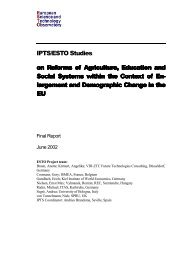Achievements of Europe's regional policy 2004-2009 - Et2050.eu
Achievements of Europe's regional policy 2004-2009 - Et2050.eu
Achievements of Europe's regional policy 2004-2009 - Et2050.eu
Create successful ePaper yourself
Turn your PDF publications into a flip-book with our unique Google optimized e-Paper software.
<strong>2004</strong>-<strong>2009</strong> Report<br />
- 13 transnational co-operation programmes covering larger macroregion<br />
areas <strong>of</strong> co-operation such as the Baltic Sea, Alpine and<br />
Mediterranean regions. ERDF contribution: € 1.8 billion<br />
- The inter<strong>regional</strong> co-operation programme (INTERREG IVC) and<br />
3 networking programmes (Urbact II, Interact II and ESPON)<br />
cover all 27 Member States <strong>of</strong> the EU and neighbouring countries like<br />
Norway and Switzerland. They provide a framework for exchanging<br />
experience between <strong>regional</strong> and local bodies in different countries.<br />
ERDF contribution: € 445 million<br />
European Grouping for Territorial Cooperation: removing obstacles to partnerships<br />
• To facilitate implementation, a key proposal <strong>of</strong> the Commission has been the<br />
European Grouping for Territorial Cooperation (EGTC). It <strong>of</strong>fers many advantages<br />
compared to the traditional partnership approach. The EGTC provisions allow the<br />
creation <strong>of</strong> a legal entity, binding cross-border partnerships together. It also provides a<br />
more stable and simple way <strong>of</strong> contracting across borders, <strong>of</strong> employing project staff,<br />
and <strong>of</strong> simplifying project finances.<br />
• Some regions are already well advanced in operating EGTCs:<br />
1. The first EGTC was created in the Eurodistrict 'Lille-Kortrijk-Tournai'<br />
between those three cities in France and Belgium. Partners are currently<br />
screening all their policies to identify those which could be implemented<br />
through the EGTC. Objectives include: promoting dialogue and political<br />
debate; ensuring consistency across the entirety <strong>of</strong> the territory, and; managing<br />
and implementing joint projects. Staffed currently by three persons, this<br />
'Eurodistrict' is aiming to increase this number to ten in the near future.<br />
2. Cross-border hospital between University Hospitals <strong>of</strong> Aachen and<br />
Maastricht: the two hospitals in Germany and the Netherlands are situated<br />
very close to each other and have a long history <strong>of</strong> cooperation, with each<br />
focused on their individual area <strong>of</strong> clinical excellence. The EGTC model is<br />
being considered as a way to further this cooperation and pushing towards the<br />
creation <strong>of</strong> a joint structure, and would help overcome obstacles such as<br />
different taxation structures and employment contract laws.<br />
• While this area <strong>of</strong> EGTC activity is very much in its infancy, the Commission believes<br />
that this multi-partner, project-level approach could become an important aspect <strong>of</strong><br />
cooperation in the future.<br />
iii) Introducing the macro-<strong>regional</strong> strategic concept<br />
• As a region where all countries are facing similar challenges, but one which also has<br />
several specific features which call for increased cooperation across the whole region,<br />
the Baltic Sea Region presents an excellent 'test case' for the new approach <strong>of</strong><br />
macro-level cooperation.<br />
• The Commission approved its Communication on the EU Strategy for the Baltic Sea<br />
Region on 10 June <strong>2009</strong>. The Strategy takes <strong>regional</strong> co-operation to a new level,<br />
19







